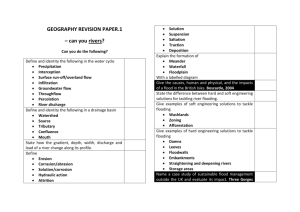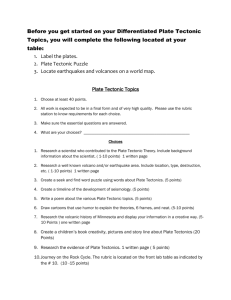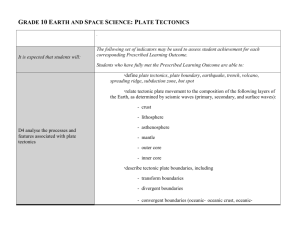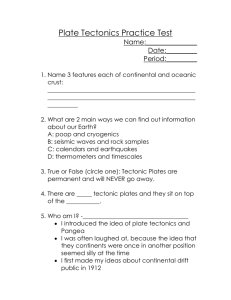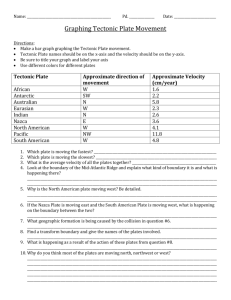File
advertisement
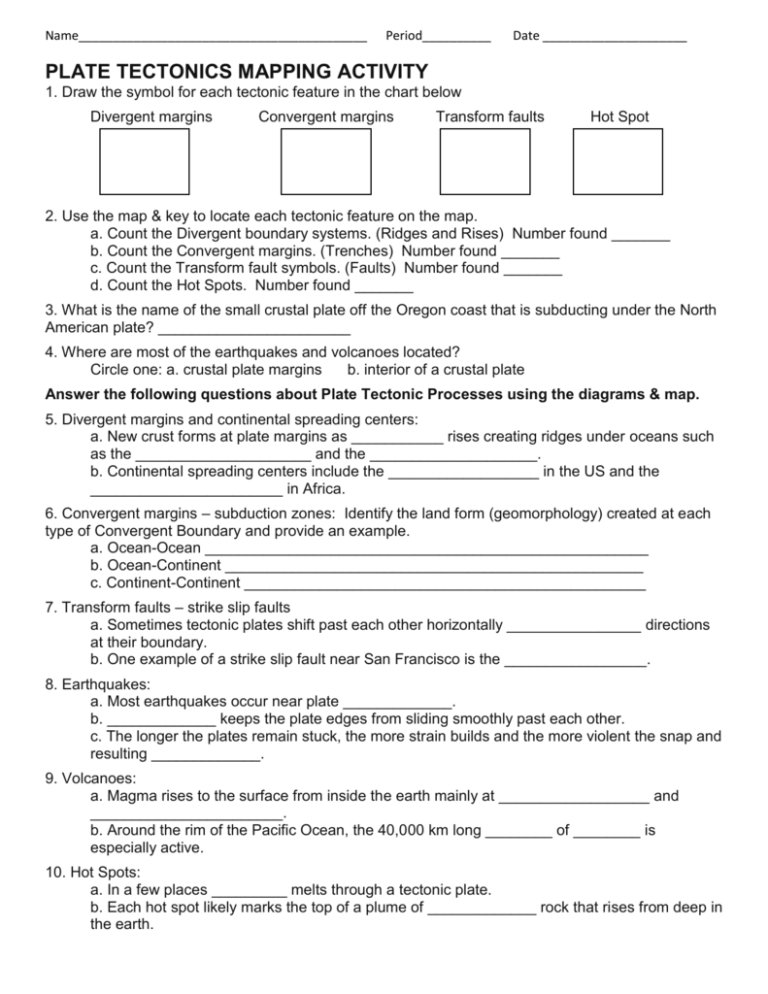
Name__________________________________________ Period__________ Date _____________________ PLATE TECTONICS MAPPING ACTIVITY 1. Draw the symbol for each tectonic feature in the chart below Divergent margins Convergent margins Transform faults Hot Spot 2. Use the map & key to locate each tectonic feature on the map. a. Count the Divergent boundary systems. (Ridges and Rises) Number found _______ b. Count the Convergent margins. (Trenches) Number found _______ c. Count the Transform fault symbols. (Faults) Number found _______ d. Count the Hot Spots. Number found _______ 3. What is the name of the small crustal plate off the Oregon coast that is subducting under the North American plate? _______________________ 4. Where are most of the earthquakes and volcanoes located? Circle one: a. crustal plate margins b. interior of a crustal plate Answer the following questions about Plate Tectonic Processes using the diagrams & map. 5. Divergent margins and continental spreading centers: a. New crust forms at plate margins as ___________ rises creating ridges under oceans such as the _____________________ and the ____________________. b. Continental spreading centers include the __________________ in the US and the _______________________ in Africa. 6. Convergent margins – subduction zones: Identify the land form (geomorphology) created at each type of Convergent Boundary and provide an example. a. Ocean-Ocean _____________________________________________________ b. Ocean-Continent __________________________________________________ c. Continent-Continent ________________________________________________ 7. Transform faults – strike slip faults a. Sometimes tectonic plates shift past each other horizontally ________________ directions at their boundary. b. One example of a strike slip fault near San Francisco is the _________________. 8. Earthquakes: a. Most earthquakes occur near plate _____________. b. _____________ keeps the plate edges from sliding smoothly past each other. c. The longer the plates remain stuck, the more strain builds and the more violent the snap and resulting _____________. 9. Volcanoes: a. Magma rises to the surface from inside the earth mainly at __________________ and _______________________. b. Around the rim of the Pacific Ocean, the 40,000 km long ________ of ________ is especially active. 10. Hot Spots: a. In a few places _________ melts through a tectonic plate. b. Each hot spot likely marks the top of a plume of _____________ rock that rises from deep in the earth. Discussion Questions: 11. Does the location of earthquakes and volcanoes show a pattern? If so, what tectonic process may be responsible? 12. Generally speaking, where are the oceanic ridges located with respect to the landmasses? What causes the ridges to form there (be specific about the process) 13. Where do you find the mountain ranges with respect to the oceanic ridges? Use examples. 14. Are there any places on Earth where the mid-oceanic ridges meet the continent? 15. What are seamounts? 16. Most of the Pacific Ocean is on what plate? 17. What is the compass orientation of the Hawaiian Islands and many of the other smaller ridges within the Pacific Ocean? What does this tell us about the plate movement? 18. In what compass direction is the Pacific Plate moving? 19. Name the biggest and longest mountain range in the world. What is it? 20. Name an island chain that has been formed by a “hot spot”. 21.What island in the North Atlantic Ocean is splitting apart? What is causing the split? 22. Where is magma rising to the surface and forming ocean crust? (zone type) Where is the oceanic crust sinking back into the mantle? (zone type) 23. Some people have referred to the process in the above question as a cycle. Why would it be considered a cycle? 24. Why is it that the Pacific Ocean floor is no older than about 200 million years and yet the continents are much older? 25. The continental margins of the East and West Coast of the United States are very different. Describe the differences. Are there tectonic differences?



